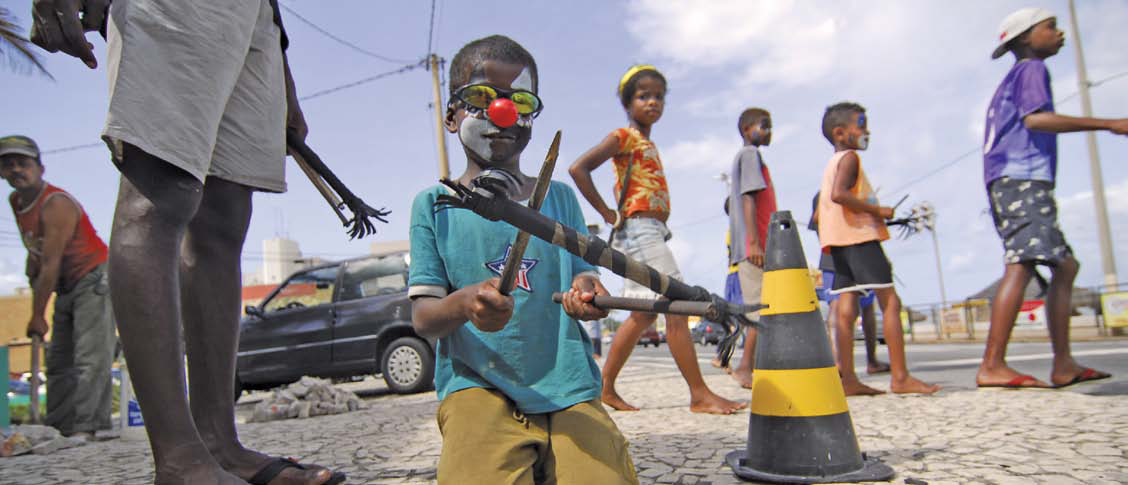
Children in an Urban World
The experiences of childhood are taking place more and more in an urban environment. More than half the world population – including more than one billion children – currently lives in large or small cities.
Many children enjoy the advantages offered by city life, such as education, medical services and sporting facilities. However, a great number do not have access to essential services such as electricity, drinking water, and health care. Instead of going to school, an immense number of children are obliged to work in conditions of danger and exploitation. More numerous still are those who have to face forced moving, even if the conditions in which they live are truly deplorable, in dilapidated habitations and overpopulated locations, strongly exposed to disasters.
The hardships suffered by children in poor communities are often hidden beneath the average statistics on which decisions concerning the allocation of resources are based, and this perpetuates the situation. Seeing that averages make no distinctions, the wealth of some persons hides the poverty of others. Children suffering from serious lack see themselves deprived of access to essential services.
There are more and more children growing up in urban areas. It is indispensible to provide them with the services and chances they need to exercise their rights and develop their capacities. Some urgent measures to be taken are:
• To better understand the importance and nature of poverty and exclusion which affect children in urban areas.
• To define and eliminate the obstacles which hinder the social inclusion of the less favoured persons.
• To guarantee that urban planning, the development of the infrastructure, the allocation of services and long-term initiatives contribute to reducing poverty and inequality, and satisfy the particular needs and priorities of children.
• To promote the creation of associations between all levels of government and the poor inhabitants of urban areas, especially children and young people.
• To combine the resources and energies of international, national, municipal and community agents so that poor and marginalized children may fully enjoy their rights.
These are not objectives but the means to attain a precise goal: to act in such a way that cities and societies may be more just and welcoming to all, and in the first place with regard to children.
When many of us think of the world’s poorest children, the image that comes readily to mind is that of a child going hungry in a remote rural community in sub-Saharan Africa – as so many are today.
But as The State of the World’s Children 2012 shows with clarity and urgency, millions of children in cities and towns all over the world are also at risk of being left behind.
In fact, hundreds of millions of children today live in urban slums, many without access to basic services. They are vulnerable to dangers ranging from violence and exploitation to the injuries, illnesses and death that result from living in crowded settlements atop hazardous rubbish dumps or alongside railroad tracks.
And their situations – and needs – are often represented by aggregate figures that show urban children to be better off than their rural counterparts, obscuring the disparities that exist among the children of the cities.
This report adds to the growing body of evidence and analysis, from UNICEF and our partners, that scarcity and dispossession afflict the poorest and most marginalized children and families disproportionately.
It shows that this is so in urban centres just as in the remote rural places we commonly associate with deprivation and vulnerability.
The data are startling. By 2050, 70 per cent of all people will live in urban areas. Already, 1 in 3 urban dwellers lives in slum conditions; in Africa, the proportion is a staggering 6 in 10. The impact on children living in such conditions is significant. From Ghana and Kenya to Bangladesh and India, children living in slums are among the least likely to attend school. And disparities in nutrition separating rich and poor children within the cities and towns of sub-Saharan Africa are often greater than those between urban and rural children.
Every disadvantaged child bears witness to a moral offense: the failure to secure her or his rights to survive, thrive and participate in society. And every excluded child represents a missed opportunity – because when society fails to extend to urban children the services and protection that would enable them to develop as productive and creative individuals, it loses the social, cultural and economic contributions they could have made.
We must do more to reach all children in need, wherever they live, wherever they are excluded and left behind. Some might ask whether we can afford to do this, especially at a time of austerity in national budgets and reduced aid allocations. But if we overcome the barriers that have kept these children from the services that they need and that are theirs by right, then millions more will grow up healthy, attend school and live more productive lives.
Can we afford not to do this?
________________
Anthony Lake – Executive Director, UNICEF
Site -> The State of the World's Child 2012
